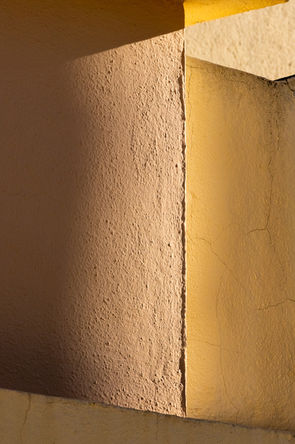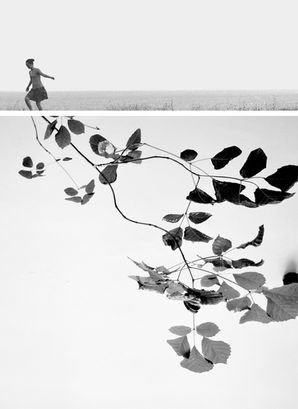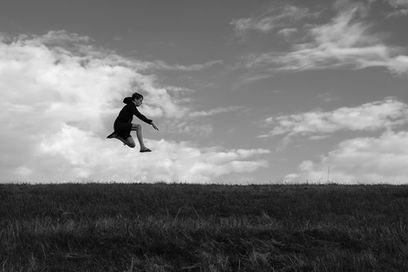
PURSUIT OF STILLNESS
October 2, 2020
INTERVIEW
PHOTOGRAPHY Maarten Rots
INTERVIEW Karin Svadlenak
Maarten Rots is a Dutch visual artist working with photography as a medium. His photographs reveal abstract qualities that can be found in everyday life, often with architecture as a prominent ingredient and a strong focus on composition, texture and colour. He started out with the production of short videos, many of which were screened at film festivals around the world, but by 2015 still photography had become his preferred medium. Maarten travels around Europe in his camper van in search of abstract images in daily surroundings. His work has been exhibited in numerous publications and platforms, and now we are honored to bring you this interview with Maarten, in which we explore his motivations, inspirations, and creative process. Join us as we discover the captivating world of Maarten Rots.

“Many of my photographs are composed of a rather rigid set of ingredients; I like to play with a limited colour palette, the effects of light and shadow and I have an interest in textures. I enjoy it when a situation isn’t too clean, a weathered surface indicates the wear and tear through time, adding a hint of history to the overall picture.”
IN CONVERSATION WITH MAARTEN ROTS
THE PICTORIAL LIST: Maarten please tell us about yourself. You have a degree in Fine Arts and started out as a film producer, quite successfully. Your films have won awards and have been screened at many film festivals. What made you decide to move your primary focus to photography? What is it that drives you?
MAARTEN ROTS: I’m originally from a relatively small town in the countryside in the East of the Netherlands called Aalten. When it comes to art there wasn’t a lot around, but I always enjoyed creating things. I used to make flyers for concerts in the area and was the vocalist in a punk band for about 10 years. After going to graphic design school I eventually ended up in Amsterdam where I attended the Gerrit Rietveld Academie. Technically I still live in Amsterdam, but for the past 5 years my wife Anne and I have been travelling with our campervan through Europe a lot so it doesn’t really feel like I still live in Amsterdam.
I have always had an interest in still photography and used photography in my work, but I never had the intention to have a photograph become the final work. When my video camera broke I decided to replace it with a DSLR to be able to film and also take photographs and from that point on I quickly transitioned into photography. It wasn’t a choice at that moment, it just happened. But I was always serious about it.
I still really had to develop my photographic skills and wanted to become more deliberate about what I photograph. To speed up that process I came up with a project called ‘Siting’ which had a set of rules. For one week I had arranged a gallery in Amsterdam to be my temporary workspace and restricted myself to photograph in a one-kilometre radius around that space only. Each day I chose one photo that would be printed on a large size and exhibited at the gallery after those seven days of photographing. Quite a bit of pressure, a lot of fun and it worked out really well, I definitely had a better understanding of what I wanted with my photography after this project. I developed a better comprehension of my own fascination which allowed me to focus better.
TPL: Your photographs are abstracted images of surfaces, textures, colours, shadow shapes. They are sometimes reminiscent of works by the painter Mark Rothko. Tell us what particularly interests you when you think of a composition.
MR: When I walk around to take photos I’m always fascinated how changing your standpoint and framing of a situation can lead to completely different interpretations of the same situation. For me the more a subject transforms through this process, the more interesting it becomes. The transformative power of the camera – translating a three dimensional setting into a two dimensional plane – is endlessly intriguing to me, all the more because the resulting picture can become ambiguous and it’s not immediately obvious what you are looking at, a reason to take a second look and change your perception.
TPL: Do you plan your photographs conceptually, or do you walk about and photograph what jumps to your eyes and put them together as series later? Where do you particularly like to photograph?
MR: I don’t plan my photographs, but I do have a clear idea of the conditions that can lead to the photographs I aim to take.
Possibly one of the most important realisations I have had over the years is to recognise when not to take a photo. When I started out I had a much broader scope of the kinds of things I would photograph and that margin has really narrowed down. When I walk around with my camera I have a part conscious and part subconscious list of the qualities that have to be in a photograph in the back of my head. This list changes over time as my interest slowly shifts, but I try to have it as clear as possible in my head. When I encounter a situation that potentially contains an interesting photograph I always surprise myself with the eventual outcome, that is definitely something that keeps me going.
I’m attracted to situations with a lot of natural light and although I like to travel to countries like Italy, Spain and Portugal where there are many more sun hours on average than in the Netherlands, I have found that I can also find these situations closer to home, or even at home. The advantage of being abroad to photograph however adds to the focus I have on my work, I have more hours to work and simply have less on my mind when I am on the road. In this perspective the location is not only important when it comes to aesthetics, but also helps me aim my attention.
TPL: Your latest series is called KONVERGENZ (Convergence). Can you explain what you mean by this title?
MR: In my photographs there are always multiple elements coming together and by choosing a certain standpoint and framing I control how this translates into a photograph. So in a sense the resulting photograph is the convergence of me being in a specific place at a specific time. When I made the photos that make up this series I was doing an artist residency at Sommergalerie Zöbing in Austria, hence a German title rather than its English translation.
Konvergenz also functions as a title on a more personal level, referring to how things sometimes just come together at the right moment. The aforementioned residency was the result of participating in an artist’s fair in the Netherlands in 2017. I used to visit this fair every year, already before I started studying arts. When I finally took part myself I met Franz Mrkvicka, the initiator of the residency and also one of the participating artists, who later invited me to come over to Austria.
TPL: Some of your work has even been turned into stained glass objects. How did that idea come about?
MR: To celebrate the Bauhaus year (2019 was the 100th anniversary of the founding of the Bauhaus), the German city of Bocholt organized a project and exhibition where they invited several artists to collaborate with craftsmen. I had always wanted to work with stained glass, but never got around to it so this was the perfect opportunity to finally make it happen.
Much of my photography is based on a strong division of fields of color and lines, and light is very important in my work, both are elements that are also of great importance in stained glass making. I had been experimenting with printing on transparent material and really wanted to take this a step further. It was an interesting experience in which I came across the limitations of the material which led to a different outcome than I initially expected - in a positive way: I’m very pleased with the resulting pieces.
TPL: One technique that is often used in abstract and experimental photography is multiple exposure. The photos in your series Fraction could be taken by the casual viewer as multiple exposures. But they are not, are they? What was your approach in taking these images?
MR: They are indeed all single exposures. The photographs in this series came about by using reflecting and transparent objects that can be found in public space. Experimenting with these conditions marked my first steps towards a more abstract direction.
In my photographs there are always multiple elements coming together and by choosing a certain standpoint and framing I control how this translates into a photograph. So in a sense the resulting photograph is the convergence of me being in a specific place at a specific time.

TPL: How would you say your photography has evolved? When one looks at your earlier work, it seems that you moved from the more concrete into the more abstract? Where do you see yourself going in the future?
MR: My photography has become more abstract indeed. It has been a gradual process without the intention to end up where I am now. I think my development has a lot to do with the amount of time I spend looking at my own work, trying to uncover visual patterns that subconsciously influence me while I am out taking photographs. When you know these things, you can be more deliberate and conscious about what you photograph, which creates space for you to subconsciously allow new elements into your photography. And so the cycle continues, you try to uncover those new patterns, etcetera.
I don’t know where I’ll end up in the future, but I’m currently very fascinated by the effects of light and shadow, so that will likely be an underlying theme for the years to come. When I am taking a photo I’m not thinking about what it is that I am trying to communicate. I’m simply trying to bring the different elements around me into the frame, to organise it on a visual level and transform the everyday situation I’m in into something miraculous. I am very aware of the influence of the elements you mention, but I try to remain open to any situation when I am out to take photos.
Once I start selecting and sequencing photographs for an edition of March & Rock or for an exhibition, the underlying themes that were mostly subconscious become more apparent. Adding or removing one photograph as well as changing the order in which they are presented has a significant influence on what a group of photos communicates. Sometimes this can be based on a feeling that I’d like to recreate by presenting a group of photos, sometimes it is the outcome of a specific visual fascination that becomes the criterion to which I measure what photos will form a series.
TPL: Do you have any favourite photographers or artists and the reason for their significance?
MR: This is always a hard question to answer, in the end it is a culmination of so many things, also the stuff you don’t like has a big influence on how you develop. And it’s not just visual art, music is also an important influence. There isn’t really one artist that stands out in that respect, but in retrospect I think seeing Saul Leiter’s work has made me realize the camera can also be used to capture and show the world in a less straightforward way.
A painter I’ve long admired is Matthias Weischer, I love his use of texture and the way he depicts spaces. Growing up I often took an MC Escher book out of the bookcase, amazed by the visual complexities in his work, and I recently discovered the sculptures of Charles Ginnever that play with a similar effect but in three dimensional space.
TPL: The Corona pandemic has affected everyone's ability to travel around as much as we would like. Has it affected your work? How are you dealing with it?
MR: Unfortunately I am currently not travelling. However, I am doing a lot of new things that I wouldn’t have done otherwise. This pandemic is horrible on so many levels, but it also allows for us to try new things. After the pandemic had us return earlier than planned, I have found myself working differently.
Before this situation I was out on the streets a lot of the time, searching for potential photographs, I only photographed what I found while walking around. Back in the Netherlands I started photographing inside the house with the same outlook, searching for compositions similar to those I find outside. The resulting photographs showed me it’s rewarding to revisit the same place at different times of the day when the light and shadows are different.
The latest chapter in these Corona-related endeavours has me photographing compositions that I create by projecting light on the wall by using coloured pieces of glass and several old projectors. A lot of the conditions that I search for when I’m photographing outside on the streets also apply to this way of working and there is still the important element of surprising myself. These photographs are more abstract - shape and colour are the main ingredients. Where my street work often still provides an opportunity for the viewer to figure out what they are actually looking at, these projection works don’t give that kind of information. There is still a lot to explore in this new approach, I’m excited to see where it will take me.
Parallel to this I have also been working on some non-photographic projects, making mixed-media collages and works with spray paint on panels, something I had wanted to do for a while, but never got around to. I’ve been enjoying this process very much. It’s a very different way of working in terms of materials and technique but my fascination for composition, textures, colour and the effects of light and shadow are still at the core of the work.
TPL: You have this super-cool customised camper/work van...we are a bit jealous of that! So, apart from being a great photographer, you seem to be quite crafty as well? Do you enjoy working with crafts?
MR: Thanks! It’s been quite a project and I’m very pleased how it turned out.
I enjoy making stuff that has a practical function, but I’m not the kind of guy that has a shed full of tools, spending all of his free time making things. Although I definitely enjoy the process of making, being able to use the thing I made is the end goal. It’s usually quite a bit of trial and error, figuring stuff out as I go, that’s how all of my creative processes work. There is a lot of information about anything you want to make on the internet, YouTube can be very helpful. And in the case of the van there were certain technical aspects where the help of friends was very welcome.
TPL: Are there any new projects you are currently working on that you would like to share with us?
MR: I am in the process of compiling the 20th edition of my magazine March & Rock, which is definitely a milestone. I started making a quarterly zine with my photography a little over five years ago and learned a lot along the way, it definitely pushed me through some harder times when I wasn’t sure where I was going with my photography. I initially started making this magazine with the intention of making a photobook at some point, and I’m really excited to share that I am currently working to self-publish my very first monograph! It will be a compilation of my photography from the past 3 to 4 years and I’m hoping to release it in the beginning of 2021. If you’d like to be among the first to know when it becomes available, sign up for my newsletter.
Next to that I have several exhibitions coming up in the coming months: a duo exhibition in Austria and several group shows here in the Netherlands and Germany.
TPL: “When I am not out photographing, I (like to)…
MR: I really enjoy being outside, walking in nature with my wife Anne and our dog Laika. It’s a great way to let go of some of the daily stuff and I always come back recharged with a clearer idea about how I can deal with things that are on my mind.
Another activity that makes me happy is cooking. It’s nice to improvise and experiment, I don’t really use recipes, usually I take a look at what I have and come up with an idea. I always keep a good variety of herbs and spices around and usually cook with whatever is available.”

Maarten Rots is a creative force to be reckoned with. His passion for travel and photography has produced some truly remarkable works of art that draw viewers in with their beauty and detail. We have had the pleasure of getting to know Maarten and discovering the inner workings of his creative process. As his journey continues, let us all be inspired to explore the world with the same passionate eye that Maarten has.















































